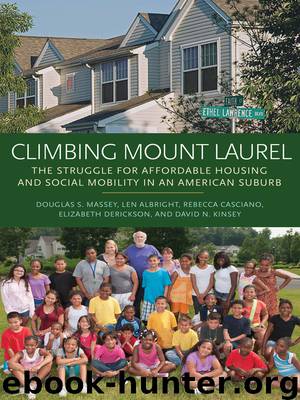Climbing Mount Laurel by Massey Douglas S. Albright Len Casciano Rebecca Derickson Elizabeth Kinsey David N

Author:Massey, Douglas S., Albright, Len, Casciano, Rebecca, Derickson, Elizabeth, Kinsey, David N.
Language: eng
Format: epub
Publisher: Princeton University Press
Published: 2013-07-15T16:00:00+00:00
After income references and positive trait descriptors, the next most common content category involved some reference to the race or ethnicity of tenants. Indeed, around 17 percent of all respondents referred to the race or ethnicity of tenants as the first word that came to mind, underscoring the continued salience of race in the United States and its central if unspoken role in the Mount Laurel controversy. Another 13 percent referred to race or ethnicity in a later word. The most common racial reference was simply to note that most residents were black or African American. Others mentioned Hispanics, and a few were surprised to note that some whites lived in the project as well.
Next in order of frequency, accounting for 12 percent of first words and 14 percent of later words, was a reference to the design, architecture, or physical character of the project itself, suggesting that, in accordance with developers’ wishes, ELH indeed succeeded in overcoming stereotypical negative views about public housing in the United States. Many neighbors seemed surprised and rather pleased that the project was composed of “well-kept,” “beautiful,” “nice,” “clean,” “spacious,” and “cute” town houses, and that the development itself was “decent,” “neat,” and “attractive.”
It was not all sweetness and light, though. One neighbor we interviewed perceived ELH residents as freeloaders, telling us, “I get ticked off because the people living there are renters. I am paying taxes for their kids to go to school, and they aren’t paying property taxes. That ticks me off.” Around 10 percent of the neighbors we surveyed mentioned a negative trait to describe residents in their first word, and another 18 percent did so in a later word. Traits commonly referred to included “noisy,” “aggressive,” “clannish,” “messy,” “sloppy,” “unstable,” “no pride,” and “undisciplined,” and some respondents explicitly mentioned “crime” and “fights on the school bus” and labeled project residents as “dangerous.” The final category consisted of a grab bag of diverse references that together accounted for just 4 percent of first words mentioned and 8 percent of later words mentioned.
Explaining the Perceptions
In order to limit the burden to respondents, minimize refusals, and mitigate potentially negative reactions to the survey, our questionnaire did not go into great detail in assessing the social, economic, political, and psychological background of interviewees. As table 6.1 suggests, however, we did gather basic social and demographic information from the people we spoke to, and here we use these data to explore the individual determinants of perceptions about the project and its residents. A key variable in all models is potential exposure to information about the project and its residents. First we consider the degree to which neighbors were exposed to the acrimonious debate leading up to the project’s construction by defining a dummy variable that equaled 1 if the respondent lived in Mount Laurel prior to 2001, and 0 otherwise. Second, we assessed the overall potential for exposure to the project by computing total years lived in Mount Laurel, assuming that the longer a neighbor
Download
This site does not store any files on its server. We only index and link to content provided by other sites. Please contact the content providers to delete copyright contents if any and email us, we'll remove relevant links or contents immediately.
| African Americans | Civil War |
| Colonial Period | Immigrants |
| Revolution & Founding | State & Local |
Cat's cradle by Kurt Vonnegut(13920)
Pimp by Iceberg Slim(12965)
Underground: A Human History of the Worlds Beneath Our Feet by Will Hunt(11283)
4 3 2 1: A Novel by Paul Auster(11093)
The Radium Girls by Kate Moore(10938)
American History Stories, Volume III (Yesterday's Classics) by Pratt Mara L(4831)
Perfect Rhythm by Jae(4638)
Wiseguy by Nicholas Pileggi(4623)
The Fire Next Time by James Baldwin(4362)
Paper Towns by Green John(4187)
A Higher Loyalty: Truth, Lies, and Leadership by James Comey(4049)
Pale Blue Dot by Carl Sagan(4030)
The Mayflower and the Pilgrims' New World by Nathaniel Philbrick(3924)
The Doomsday Machine by Daniel Ellsberg(3746)
Too Much and Not the Mood by Durga Chew-Bose(3707)
Killers of the Flower Moon: The Osage Murders and the Birth of the FBI by David Grann(3638)
The Borden Murders by Sarah Miller(3600)
The Sympathizer by Viet Thanh Nguyen(3537)
Killing England by Bill O'Reilly(3472)
